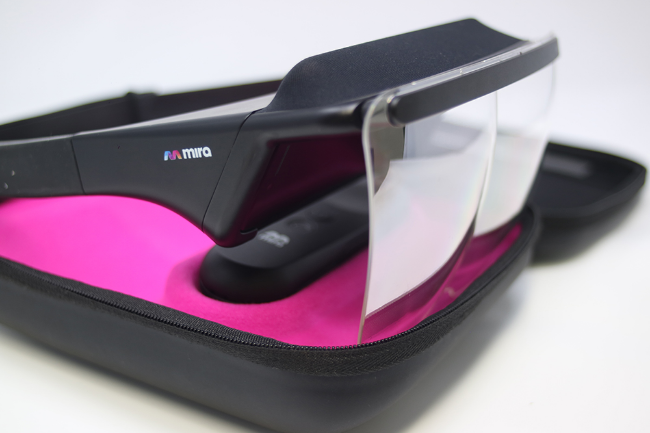
24 Oct Mira Prism Augmented Reality Review
Bottom Line Up Front (BLUF)
Pros
- Untether Augmented Reality
- Low-cost
- Reuse of user-owned hardware (iPhone)
- 60 Degree Field of View (FoV)
Cons
- Limited virtual environments
- Uncomfortable after long periods of use
- Licenses fees for deployment
- Limited to iPhone 6, 6S, 7, and 8
Technical Review
This is a low-cost augmented reality solution that developers can purchase for $150 USD*. I really like the simplified industrial design which utilizes a mesh-screen system to lock the phone into place and uses magnets to attach the lens.

The Mira Prism hardware consists of the following:
- Mira Stereo Camera Rig, a plastic head mounted jig that holds the phone
2. Magnetically attachable lens
3. Three Degrees of Freedom (3 DoF) Remote control
4. Welcome and setup pamphlet
5. Lens cover which doubles as a wipe for the lens
6. Two-sided marker for image recognition and tracking
7. Carrying case that holds all the items listed above

I really like the Field of View (FoV) of the Mira Prism, it’s documented at a whopping 60 degrees horizontal when compared the Microsoft HoloLens at 35 degrees horizontal and Magic Leap at 40 degrees horizontal. It’s noticeable and the images fill most of my forward-looking field of view. It was easy to transition between the Augmented Reality (AR) environment and the real world, meaning I was able to wear the Mira Prism and operate items in the real world around me.

It’s front heavy so the balance needs tweaking which makes it uncomfortable when wearing for long periods of time. The Mira Prism slowly slides down and if the Velcro strap is tightened enough where it doesn’t slide down… the user could very well pass out due to lack of blood flow to the brain… JK, but be prepared for a pounding headache if you tighten the strap too much.
The development environment use Unity which is the standard tool for consumer level AR products. Hardware is $150 which is awesome, but the licensing fees for deployments are something to be aware of. I appreciated the reuse of user-owned hardware, but its limited to a few iPhone models. At the time of this review, I have not explored the audio so check back for updates on the review. Mira Software Development Kit (SDK) documentation is posted on their website but was slightly outdated at the time of this review, meaning the documentation speaks to something other than the latest version of the SDK. Additionally, the documentation doesn’t help much with troubleshooting.

Development Environment
The development environment is tied to Unity & XCode which is a limited Integrated Development Environment (IDE). I would like to see Mira SDK plugins for other development environments such as Unreal Engine and Lumberyard. The Mira SDK utilizes Wikitude Computer Vision for six Degrees of Freedom (6 DoF) Marker, Image, and 3D Tracking. Additional features of the Mira SDK include the following:
- Mira Stereo Camera Rig
- Gyroscope-based rotational tracking
- Counter-distortion Rendering
- 3 DoF Bluetooth controller and event/raycast system
- Live Preview for testing all Mira interactions without having to build to iOS (I’ve yet to get this to work)
The unit under review is a developer’s kit so it’s understood that there are future features forthcoming. With that being said, this is a great platform to start out with if you’re new to Augmented Reality (AR) development or if you need to quickly prototype some concepts for a demo.
*price as of 10/17/2018




